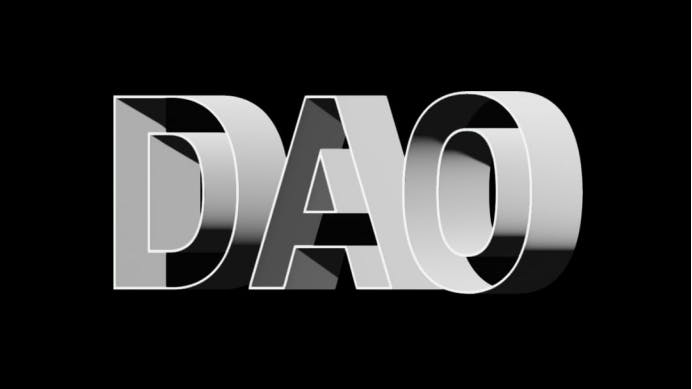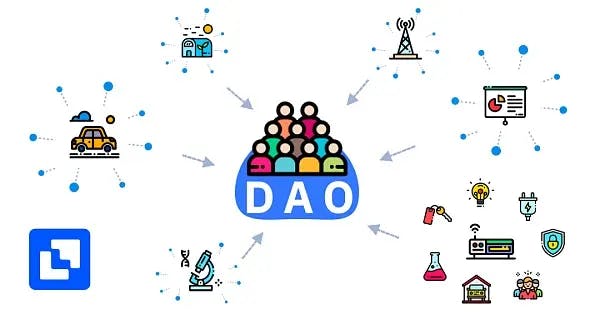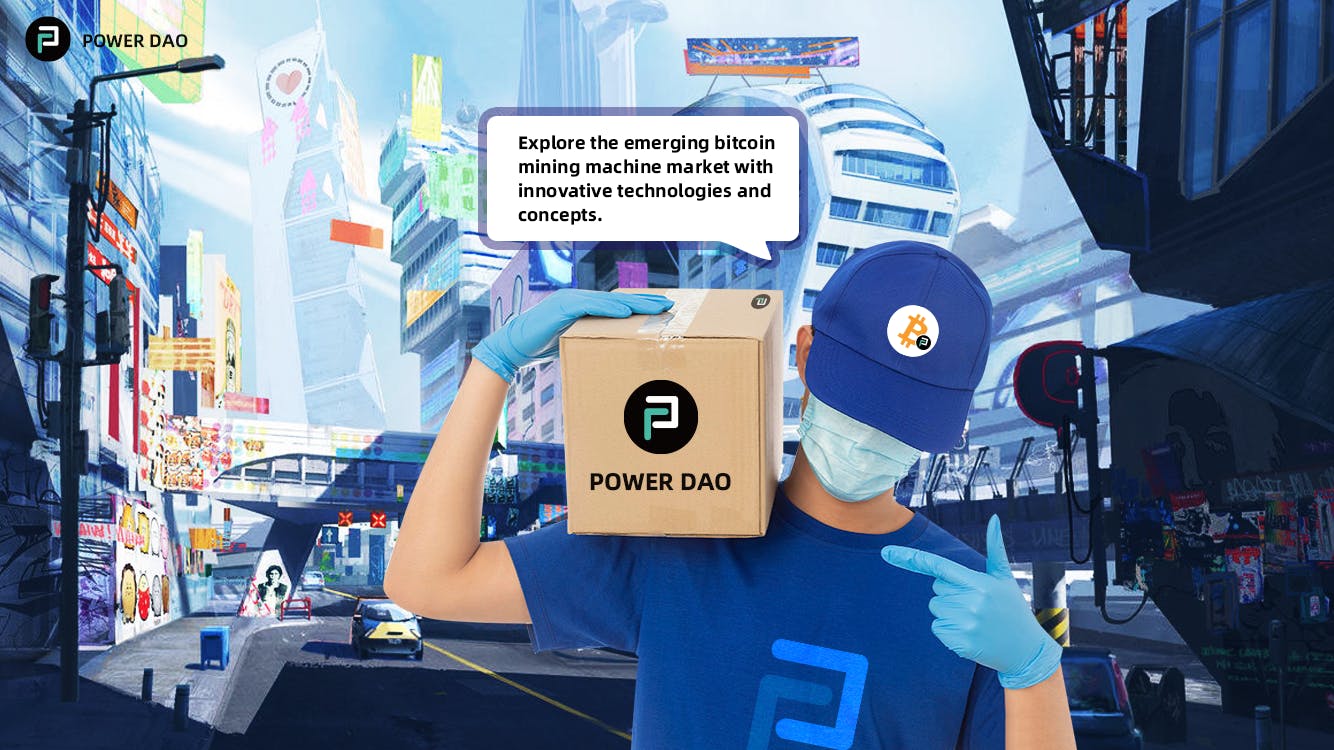The importance of DAO democratic voting governance

The concept of decentralization is subversive. For thousands of years, we have been telling stories in order, and the more orderly, the more civilized we are. And the final form of this order is to form a series of centralized institutions.
Vitalik (Founder of Ethereum) defines a DAO as "an entity that lives on the network and exists independently, but also relies heavily on people to perform certain tasks that it cannot do by itself". Richard Burton said it even more explicitly: "A DAO is a fancy way of being a digital system that lives on top of Ethereum." Decentralized Autonomous Organizations will decentralize, "autonomy," and communicate The integration of economic incentives and the capitalization of various elements on the blockchain to maximize organizational efficiency and value transfer.
DAO is a charismatic organizational form that has unparalleled advantages in realizing common ownership of public goods, eliminating corruption risks in the public welfare sector, and achieving non-profit organizational goals. However, these advantages must be combined with a benign voting decision-making mechanism, a fair contribution measurement and reward mechanism, and strong governance scalability in order to achieve democracy. This article will introduce some typical and interesting voting decision-making mechanisms that we think are typical. Although these voting mechanisms are not the key to solving all problems, their governance ideas have extraordinary positive significance.

Voting mechanism in governance process
The governance of DAO is a kind of democratic governance with the participation of community members. Although there are various forms, the essential goals of these governances are to achieve trustless common management with the help of blockchain technology. The means to achieve this is the voting mechanism.
The governance of DAO can generally be considered to be composed of six steps: proposal, review, voting, execution, dispute, and arbitration. Proposals are member-initiated suggestions for changes to the community, grant applications, or asset changes. Each proposal must be passed in the voting stage before it can be implemented. Normally, the proposal is completed at this point, but some members may be dissatisfied with the voting results or believe that there is cheating in the voting process. At this time, it is time for the dispute. If the dispute is accepted, it will enter the arbitration stage. The Decentralized Court is built for this, and members who are dissatisfied with the outcome can apply to the Decentralized Court for arbitration, and the Decentralized Court will adjudicate them. In this governance process, the core is the voting stage. It can be considered that the voting mechanism acts as the CEO of the traditional company, and the wisdom of the CEO comes from the consensus of the entire DAO organization members.
Status of voting in the governance process
The following is a summary of the current common DAO voting mechanisms:
1.Permissioned Relative Majority. The most common way is in the form of 1p1v and 1t1v. Proposals need to be initiated by Dao members before they can be voted on. Only by comparing the relative familiarity of the total number of affirmative votes and negative votes can we get a relatively majority of the voting results. It is widely used, such as Moloch Dao, metacartel ventures, vote Dao and daohaus.
2.One Person, One Vote. This voting method is widely used in traditional elections. It means that every member, no matter how many tokens they hold, are equal to "one person, one vote". The advantage of this voting method is simplicity, the disadvantage is that it is vulnerable to Sybil attacks. Currently, Proof of human DAO takes this approach.
3.Representative Voting. Representative voting means that voters entrust their power to a representative and let the representative exercise the right to vote for him. The U.S. general election is a kind of representative voting. In the blockchain, the DPOS consensus algorithm is a typical representative voting, and BitShares adopts this voting mechanism.
4.Vote Delegation/Liquid Democracy. Liquid democratic voting is a variant of representative voting. It was first adopted in Aragon. It means that members can delegate their voting rights to other people they trust to vote. Delegators can continue to delegate others to vote. When a delegate votes, the votes of all voters directly or indirectly delegated to him will be cast at the same time. If any delegator is dissatisfied with the votes of his delegates (including his indirect delegates), he can choose to vote directly or to re-delegate others to vote. This voting method gives voters a higher degree of freedom and can increase voting participation. Currently, the Governor DAO provided by Compound uses this voting method.
5.Off-chain Voting on-chain Execution. This voting method does not perform expensive computations on the chain, but directly submits the results. In this way, an off-chain voting tool like Snapshot is usually used for voting, and a multi-signature wallet is used for uploading. Currently, Raible, Perpetual Protocol and BitDAO are using this method. The advantages of this method are efficiency and cheapness, and the disadvantage is that it increases the risk. In extreme cases, there is no way to prevent multisig members from doing things not decided by the community.
6.Optimistic Governance. Optimistic governance uses a DAO to replace multi-signature, and any member of the DAO can stake a certain amount of tokens to upload voting results. However, anyone who disagrees with the result can go to court to initiate a dispute, and the loser will lose the staked tokens. This approach increases security, but also introduces more complexity.
7.Conviction Voting. Conviction Voting is a dynamic voting mechanism based on the voter's conviction. When a user chooses to participate in a proposal to vote, a conviction value will be attached to the voting power, and the conviction value will increase at a half-life curve rate to a certain limit according to the duration of the user's participation in the proposal. When a user decides to transfer governance rights to another proposal, the user's conviction value will gradually decrease according to the half-life curve rate, just like a small hole in a bucket, and the water in the bucket will slowly drain. This mechanism can avoid chaebol domination, witch attack problems. However, this mechanism is complicated in implementation and use, and is currently used in 1Hive.
8.Holographic Consensus. which is the Futarchy mechanism. First proposed by Robin Hanson in 2000, the model that combines governance voting with prediction markets aims to solve the shortcomings of traditional democracy. Under this system, individuals no longer vote on whether to implement a particular policy, but instead vote on metrics to determine how their country (organization or company) should function, and then predict the market to choose the policy that optimizes the metric. When deciding whether to implement or reject a policy, two prediction markets are created, one for predicting the outcome when the policy is adopted and the other for predicting the outcome when it is rejected. And, the final policy acceptance will be determined by asset prices in both markets. If the final policy is accepted, all trades in the "against market" will be returned, and the "accepted market" will, after a period of time, judge the success of the policy according to the chosen metric. If the policy is successful, a certain fee will be rewarded based on the amount of assets held by each member in the "accepting market", and the operation when rejected is similar. This method can use economic incentives to collect information and fully mobilize collective intelligence, but its operation process is too complicated, so it has not been widely used. At present, the Futarchy mechanism has been used in many projects such as Gnosis DAO, Amoveo, and Tezons.
9.Quadrac Voting. Vitalik (Founder of Ethereum) proposed a voting mechanism between 1T1V and 1P1V (one person, one vote). Allows a single voting topic to vote repeatedly for the same option to express the strength of its preference. At the same time, in order to prevent giant whales from monopolizing the right to speak, the marginal cost of repeated voting for the same option shows a decreasing trend. (The calculation formula is very special, that is, for a given project, first take the square root of each donation amount received, add these square roots, and finally take the square output of the addition result, which is the matching project. Total funding amount. For example, one vote for the same option consumes 1 Token, 2 votes for it consumes 4 Tokens, 3 votes for it consumes 9 Tokens, and so on, 10 votes for it, It needs to consume 100 Tokens.) For example: Gitcoin, Ethereum community governance.
Existing case studies of voting governance
1.Protocol. There are three well-known voting-related protocols, namely Compound Governor, Moloch DAO and Gensis Protocol. Compound is a DeFi project for providing a developer-friendly, automatic interest-bearing protocol. In Compound, a governance protocol, Compound Governor, is provided for the governance of DeFi projects. It is based on the liquid democratic voting mechanism, and this protocol is currently used by many leading projects, such as Uniswap, Radicle and Cryptex. Moloch protocol is the governance protocol adopted by Moloch DAO, which adopts a voting mechanism with restricted permissions. Since MolochDAO is itself a financing DAO, moloch is favored by both investing DAOs and financing DAOs, and is currently used by many projects including MetaCartel Ventures, Raid Guild, and DAOhaus. Another protocol, Gensis Protocol, is a protocol developed by dxDAO to experiment with its proposed holographic consensus mechanism (a Futarchy mechanism), which is currently mainly used on the dxDAO platform.
2.The voting component in the DAO platform. Some DAO construction platforms provide voting tools with multiple mechanisms. A typical example is Aragon Governor. In addition to optimistic governance, Aragon also provides apps such as belief voting and liquid democracy voting. In addition, Aragon also integrates third-party tools such as Vocdoni and Snapshot.
3.Decentralized infrastructure. Taking POWER DAO as an example, through the on-chain voting governance method, the governance token POWER Miner (PM) is to allow each unit of algorithmic power to provide algorithmic power pledge votes for Bitcoin, Ethereum and other emerging public chains independently, flexibly and unrestrictedly. And obtain incentive tokens, and at the same time form a strong algorithmic power competitive advantage with the consensus power of DAO. It aims to realize the bridge between the physical world and the byte world - "Algorithmic power", thereby redefining the credit and value of algorithmic power, and using "Algorithmic power" as a value credit medium, it will solve the problems of Bitcoin, Ethereum, etc. The algorithmic power of the public chain is gradually falling into the situation of centralization and monopoly, and at the same time, it will elect the foundation of the next generation with higher performance, lower energy consumption, more decentralization, and more security that can support Web3 in a flexible way of voting by pledge of algorithmic power facility.

The future of DAOs
With the huge growth in the size of the Web3, Metaverse, DeFi and NFT communities, how to govern decentralized protocols becomes even more important. One of the most pressing challenges facing these communities, now and in the future, is addressing governance—that is, managing collective decision-making to optimize funding and operations.
However, governance requires significant coordination costs, as network participants need to be involved in voting on every decision. These coordination costs can be drastically reduced by a new type of decentralized network, the DAO (Decentralized Autonomous Organization). In a DAO, smart contracts enable participants to govern in a cooperative manner. "Code is law." The operation of each protocol strictly follows the code and cannot be tampered with.
In a new network of DAOs, people come together with a common motivation and common interests, there is no single leader or single point of failure, and it is run almost entirely by code. Many new decentralized protocols are being built using this structure, and to date, in many ways, DAOs can be seen as a combination of investment banks, corporations, and social clubs, bringing these roles together through cryptographic promises.